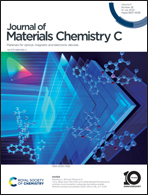Eco-compatible solvent-processed high energy level offset ternary strategy for efficient organic photodetecting and photovoltaic applications†
Abstract
We designed a ternary strategy for efficient and stable organic electronic devices (OEDs) by introducing high lowest unoccupied molecular orbital (LUMO) level 5,5′-[[4,4,9,9-tetrakis(2-ethylhexyl)-4,9-dihydro-s-indaceno[1,2-b:5,6-b′]dithiophene-2,7-diyl]bis(2,1,3-benzothiadiazole-7,4-diylmethylidyne)]bis[3-ethyl-2-thioxo-4-thiazolidinone] (EH-IDTBR) as a third component acceptor. We investigated the photovoltaic and photodetection properties of the EH-IDTBR-ratio-dependent active-layer-based OED via current–voltage characteristics under both light and dark conditions using atomic force microscopy (AFM), trap density, impedance spectroscopy, and photoresponse speed measurements. Among the four types of active-layer-based devices, the optimized EH-IDTBR-ratio-based ternary device provided the most effective photoelectric conversion and dark current suppression properties. These desirable properties originate from the high energy level offset of EH-IDTBR, and also it has superior intermolecular charge transport and can withstand degradation by externally stimuli, such as oxidation and applied bias. We confirmed the anti-degradation behavior and resulting OED performance through various analyses.

- This article is part of the themed collection: 2023 Journal of Materials Chemistry C HOT Papers


 Please wait while we load your content...
Please wait while we load your content...